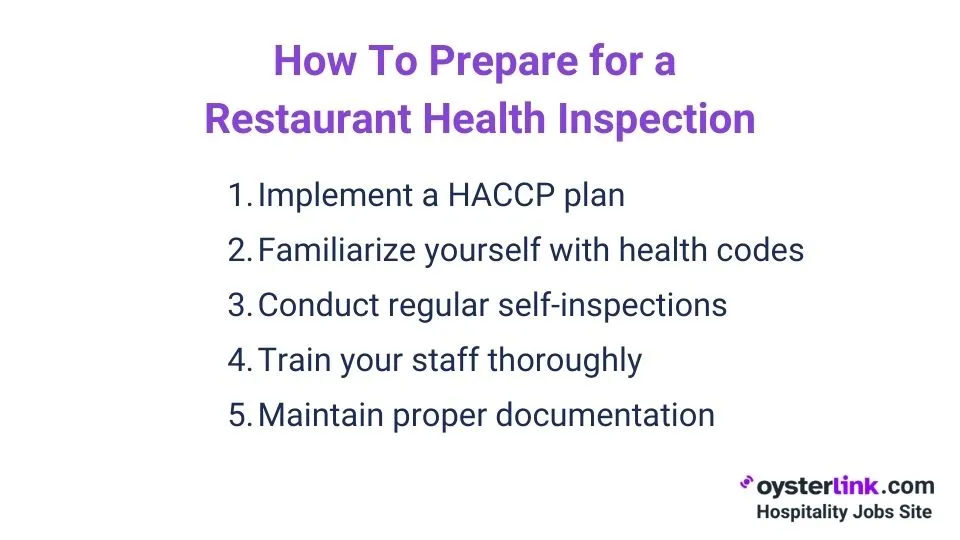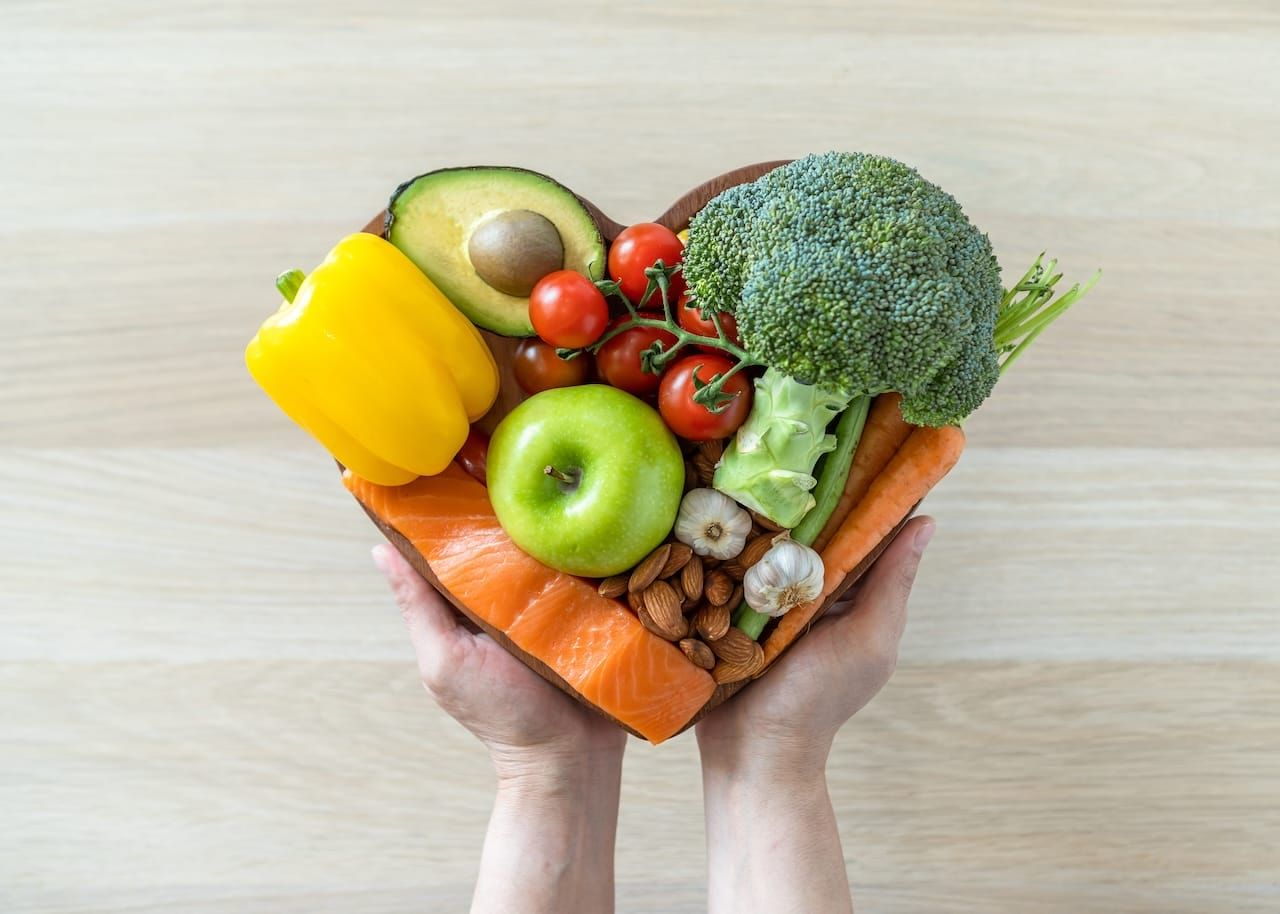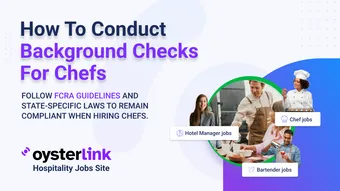A health inspection can feel like one of the most nerve-wracking moments for any Restaurant Manager or owner.
Even if you run a clean and well-organized establishment, the thought of a surprise visit from an inspector can stir up anxiety.
But here’s the thing — a restaurant health inspection doesn’t have to be stressful. In fact, with the right preparation, it can become just another routine part of running your business.
In this guide, we’ll break down exactly how to get your restaurant inspection-ready, from organizing your records to training your staff.
Key Areas of Focus During Health Inspections
Health inspectors pay close attention to several critical areas during their evaluations.
Understanding these focus points can help you prepare more effectively:
- Food temperature control: Inspectors check if hot food are kept above 140°F and cold foods below 40°F. They may use thermometers to verify the temperatures of stored and served items.
- Food handling practices: Proper handwashing, use of gloves and prevention of cross-contamination between raw and cooked foods are essential.
- Kitchen cleanliness: Surfaces, equipment and utensils must be spotless, with proper sanitization methods and no visible dirt or grease buildup.
- Pest control: Evidence of rodents or insects is a serious violation. Inspectors assess your pest control measures and look for signs of infestation.
- Employee hygiene: Inspectors observe handwashing practices, hair restraints and overall cleanliness of staff attire.
- Facility maintenance: Ventilation, lighting, plumbing and the overall physical condition of your restaurant are evaluated.
Restaurant Health Inspection Prep: 5 Key Tips for Success
Preparing for a restaurant health inspection is not just about passing a test — it's about building a culture of food safety that supports both the well-being of your customers and the smooth operation of your business.
Following these strategies will help ensure you're ready to pass your inspection with confidence and maintain a high standard of cleanliness and safety.

1. Implement an HACCP plan
A robust Hazard Analysis and Critical Control Points (HACCP) plan is the foundation of food safety in any restaurant.
This system helps you identify and manage risks throughout your food preparation, storage and service processes.
For instance, if you serve raw seafood, your HACCP plan would specify critical control points, such as proper storage temperatures and handling procedures, to prevent contamination.
Keep your HACCP plan up to date with menu changes, new equipment or operational adjustments. This proactive approach minimizes foodborne illness risks and ensures smoother inspections.
2. Familiarize yourself with health codes
Health codes and regulations can evolve, and staying on top of these changes is essential.
For example, local ordinances may introduce new rules for allergen labeling or modify temperature control requirements.
Set aside time each month to review updates to local health guidelines.
You can subscribe to local health department newsletters or attend industry workshops to keep informed. It’s important to communicate these updates to your team so they can adjust procedures accordingly.
3. Conduct regular self-inspections
Conducting regular self-inspections is one of the most effective ways to stay ahead of health inspections.
They help you identify and address discrepancies before the official inspection, reducing surprises and ensuring compliance.
To make this process easier, create a checklist that mirrors the health inspector’s, focusing on key areas such as food storage, sanitation practices and employee hygiene.
Regularly check that refrigerators are set to the correct temperatures, verify that food is properly labeled and stored and ensure cleaning supplies are always available and consistently used.
Assigning a team member to handle these self-inspections can also help catch potential issues that might be overlooked during the daily rush.
4. Train your staff thoroughly
Your staff is your first line of defense against health violations, so ensuring they are well-trained is critical.
Comprehensive training should cover everything from basic food handling and storage techniques to proper handwashing and cross-contamination prevention.
Your team should know that raw meats should be stored on the bottom shelves of refrigerators to prevent their juices from contaminating other foods.
Regular, hands-on training sessions are essential, but periodic refresher courses are equally important.
This helps reinforce good habits and keep food safety top of mind.
Additionally, consider using food safety apps like SafetyCulture or Foodkeeper App to provide ongoing education to your team and keep them updated on any new protocols.
5. Maintain proper documentation
Accurate and well-organized documentation is not only essential for internal management but also for proving your commitment to food safety during inspections.
Keep detailed records of food deliveries, temperature logs for refrigerators and freezers, sanitation procedures and staff training sessions.
For example, if the inspector asks for temperature logs, having them on hand shows that your restaurant consistently monitors food safety.
Keep these documents in a centralized location, such as a digital file or binder, to make them easy to access during the inspection.
If discrepancies are noted, documentation can help demonstrate that corrective actions were taken in a timely manner.
Restaurant Health Inspection Checklist

To ensure your restaurant passes a health inspection with flying colors, it’s important to stay organized and prepared.
A comprehensive checklist is an essential tool for maintaining food safety, cleanliness and compliance with health regulations.
Use the following Restaurant Health Inspection Checklist to help guide your preparation and ensure that all critical areas are covered before the inspector arrives.
| Category | Required practices |
|---|---|
| Food storage and handling | • Store food at least six inches off the floor to avoid contamination and pests. • Label all food containers with names and dates to ensure proper use within recommended time frames. • Implement and follow the First-In-First-Out (FIFO) inventory method to use older stock first. • Separate raw and cooked foods to prevent cross-contamination. • Store chemicals away from food items to avoid contamination. |
| Temperature Control | • Regularly check and log refrigerator temperatures (below 40°F or 4°C) to ensure food safety. • Maintain freezer temperatures at or below 0°F (-18°C) to prevent spoilage or bacterial growth. • Use calibrated thermometers for accurate readings to ensure proper food temperatures. • Monitor hot-holding temperatures (above 140°F or 60°C) to prevent bacterial growth in hot foods. |
| Cleanliness and sanitation | • Establish and follow a regular cleaning schedule for all areas, including kitchen, dining and storage. • Use appropriate sanitizing solutions for food contact surfaces to maintain hygiene. • Clean and sanitize utensils and equipment between uses to prevent cross-contamination. • Maintain a clean and organized dry storage area to reduce contamination risks. |
| Employee hygiene | • Enforce proper handwashing procedures to ensure employees maintain hygiene, especially after handling food. • Provide and maintain handwashing stations with soap and paper towels for easy access. • Ensure employees wear clean uniforms and appropriate hair restraints to avoid contamination. • Prohibit sick employees from handling food to prevent contamination from illness. |
| Pest control | • Implement an effective pest management program to prevent pests from entering the restaurant. • Regularly inspect for signs of pest activity, including droppings or damage to food. • Seal potential entry points for pests to prevent them from entering the premises. • Keep outdoor areas clean and free of debris to reduce the risk of attracting pests. |
By staying on top of these key practices, you can help create a safer environment for both your staff and customers.
The Day of the Inspection: What To Expect
When the health inspector arrives, it's important to stay calm and cooperative.
The process typically begins with the inspector introducing themselves and explaining the purpose of their visit.
They will then conduct a thorough walkthrough of your facility, carefully observing your practices and checking key areas such as food storage, sanitation and temperature control.
During the inspection, the inspector may ask questions about your procedures or request to see documentation, such as temperature logs or cleaning schedules.
They will also note any violations they observe, and in some cases, may provide immediate education on how to address these issues.
Once the inspection is complete, you'll receive a summary of the findings.
If any violations are noted, the inspector will provide a list of items that need attention, along with a timeline for correction.
It’s important to take this feedback seriously, as it helps ensure your restaurant meets health and safety standards.
Post-Inspection Procedures

After a health inspection, it's crucial to take immediate and organized steps to address any findings.
Here’s what you should do:
- Review the inspection report carefully: Read the report thoroughly to understand any issues or violations noted by the inspector. This is essential for addressing concerns effectively and staying compliant.
- Address violations immediately: Start by correcting the most critical violations first. These are the issues that pose the greatest risk to food safety and health. Prioritize actions that could lead to immediate hazards, such as improper food storage or temperature control failures.
- Develop an action plan for long-term improvements: If the inspection reveals ongoing concerns, consider creating an action plan to improve your restaurant’s food safety practices. This might involve updating procedures, upgrading equipment or revising your cleaning schedule.
- Communicate findings and necessary changes to your staff: Make sure all team members are aware of the inspector’s findings and the changes needed to stay compliant. Clear communication is key to preventing future violations.
- Schedule a follow-up inspection if required: If the inspector issues a violation that requires correction within a certain time frame, schedule a follow-up inspection to confirm that improvements have been made. Ensure that any necessary actions are completed before the follow-up.
If violations are left unaddressed after multiple inspections or if corrective actions are insufficient, more severe penalties (such as longer suspensions or permanent closures) could be enforced.
Building a Culture of Food Safety

Building a strong food safety culture in your restaurant is key to long-term success.
It starts at the top — when management leads by example and consistently follows proper food safety practices, the team is more likely to take them seriously and do the same.
Make food safety part of everyday conversations with your team. Talk about it during meetings, training sessions or even quick check-ins to keep it top of mind.
Recognizing and rewarding staff who stick to food safety protocols helps reinforce good habits and motivates everyone to maintain high standards.
It’s also important to create an environment where staff feel comfortable sharing concerns or suggesting improvements.
Open communication goes a long way in keeping food safety a priority.
Platforms like OysterLink can be a great resource for ongoing training, connecting with food safety experts and sharing best practices across your team.
This kind of proactive approach ensures that food safety isn’t just a set of rules to follow — it becomes a core part of your restaurant’s identity.










Loading comments...